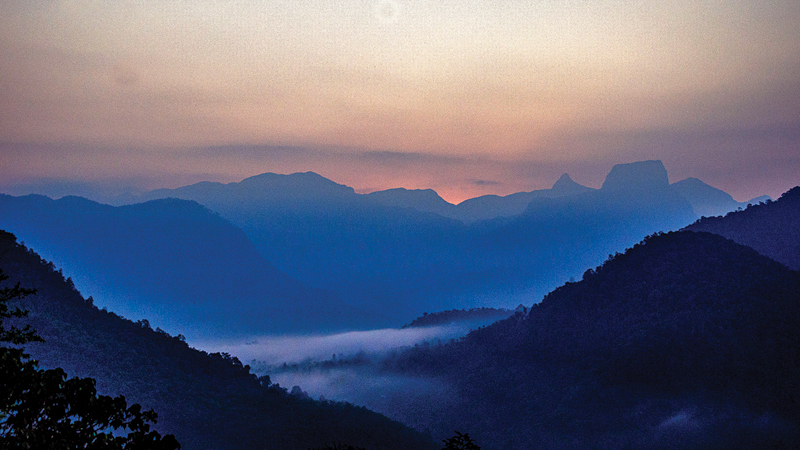There is so much to see, sense and hear of the mountain of Batatota where the mythical cave called Diwaguhawa is believed to be encased in thick jungle, on the slopes of peak wilderness valley in Erathna.
 Tea pluckers busily walk among the bushes in tea estates in the undulating mountain ranges which stretch as far as eye can see. Adam’s Peak or Sri Pada rises abruptly through the lower mountain ranges. The cool cascading streams flow through mountainous valleys. Mist and clouds cover the summits of them.
Tea pluckers busily walk among the bushes in tea estates in the undulating mountain ranges which stretch as far as eye can see. Adam’s Peak or Sri Pada rises abruptly through the lower mountain ranges. The cool cascading streams flow through mountainous valleys. Mist and clouds cover the summits of them.
The sleepy village called Erathna, a mountainous hamlet close to Kuruwita, is enriched with natural beauty and wilderness. The village is on the mountain range of Adam’s Peak and the Kunudiya Parwathaya rocky hill. One of the arduous routes to Adam’s Peak commences from Erathna. It leads to the summit through extreme wilderness and is most adventurous. Most young pilgrims to Adam’s Peak prefer the Erathna route because it gives you the opportunity to experience natural environment and salubrious climate, right up to the summit.
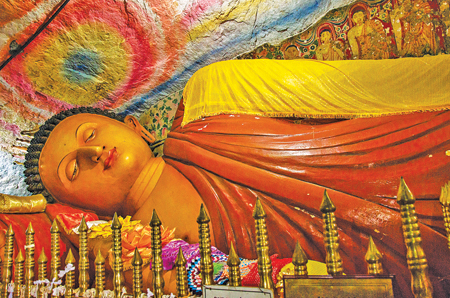
The reclining Buddha statue in the main cave shrine
These days Erathna comes alive since the Sri Pada season has started. Hundreds of Sri Pada pilgrims select the Erathna trail to climb the Sri Pada and sleepy Erathna town is busy with pilgrims. The villagers of Erathna make a living mainly through small scaled tea plantations and by making jaggery from Kithul trees. They sell them to merchants who come from distant areas.
We have travelled a few kilometres in Batatota, a small village in Erathna and arrived at a famous archaeological site called Diwaguhawa. The site is not only famous for its ancient Buddhist hermitage, but also for majestic dagaba and ancient murals. What most appeals to visitors are the wilderness and the panoramic view of Adam’s Peak which is in the Eastern horizon.
Famous religious site
The Batatota cave temple, or Diwaguhawa, which was once neglected, has now earned fame as a religious site. It is also held in high esteem by the Buddhist community in Sri Lanka.
The cave temple is visited by pilgrims with great devotion and respect. During weekends and holidays, hundreds of visitors’ throng this ancient place. Sri Pada pilgrims who return from pilgrimage never hesitate to visit this hallowed shrine during the Sri Pada season. A spacious car park has been built on the top of the mountain close to the temple for the benefit of the visitors. Villagers sell food, made by them, to pilgrims along the road to the cave.
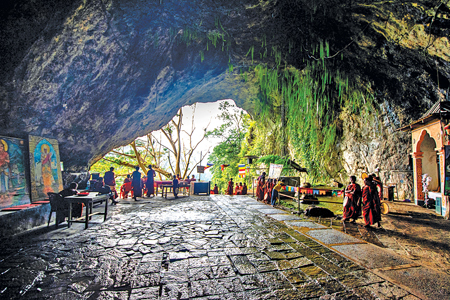
The inside view of the Batatota cave temple
The Batatota Ancient Cave Temple Renovation Society (BACTRS) took the initiative to commence a program to renovate the cave temple as it has been of religious significance to the Buddhists in the country.
Legend has it that this cave temple was built by King Nissankamalla (1178-1207) during the Polonnaruwa period. During this time, the king had accidently discovered the temple on his way to Adam’s Peak. The Batatota Cave Temple also holds importance for the fact that Buddha rested there with 500 of his disciples, on his return from Adam’s Peak. Legend also says that the Buddha rested in this cave after placing his footprint on the Adam’s Peak by the invitation of God Sumana Saman, the guardian deity of the Adam’s Peak.
King Nissankamalla had built the temple which exhibits the country’s rich culture. The most impressive architectural feature in this cave temple is its magnificent Makara Thorana that dates back to the Polonnaruwa period. A part of it has been renovated by the villagers as it had been disfigured.
In the cave shrine, one can see several crossed-legged and reclining Buddha statues. However, it is difficult to ascertain the period which they belong to. Most of the statues and paintings in the cave temple have been exquisitely renovated several times.
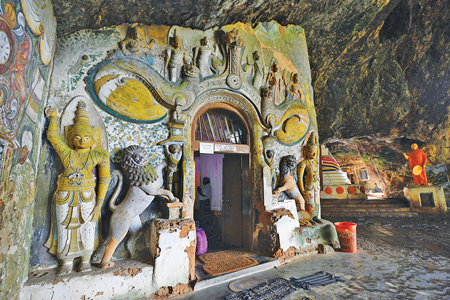
The Makara Thorana at the entrance to the cave shrine
The paintings have been touched-up at different times. In 1908, this isolated cave had been rediscovered by an erudite bhikkhu called Ven. Sri Subethi Thera who took great care to renovate it and built a devale (A place where religious rites are held for gods) outside the shrine. After Ven. Subethi’s demise, the site was abandoned. As a result, this site had become a haven for treasure hunters who destroyed most of the invaluable statues in the cave.
Site on Erathna trail
In 1995, most Ven. Balangoda Ananda Maithreya Mahanayaka Thera identified this ancient cave temple as Diwaguhawa. His discovery was accepted by the people visiting the ancient site. Finally, it became a famous Buddhist site among the devotees who make an annual pilgrimage to Adam’s Peak, via the Erathna trail. During our short stay at the cave,we witnessed Buddhist traits in a serene atmosphere.
The most remarkable feature in the cave temple is the falling of drops of water from the cave ceiling, even during dry weather. There is also a pond. Rays of sunlight fall inside the cave in the early morning. Adam’s Peak can be viewed from within the cave magnificently. The mesmerising sight of rising sun can be viewed from the summit of the Batatota cave in clear days.
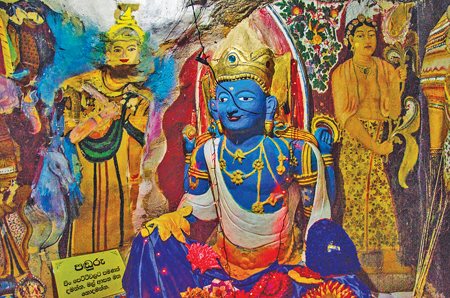
The statue of deity Vishnu in the cave shrine belonging to the Kandyan period
Sthreepura is another cave 200 metres away from the main cave. This cave is believed to be one of the shelters of a relative of God Saman.
The Adivasi community is of the view that this cave belongs to their forefathers. The chief of the Veddah community Uriwarige Wanniyale Attho regularly takes part in many ceremonies that are organised at the Batatota Cave Temple.
Ven. Rassagala Chandakiththi Thera, who became the chief incumbent of the temple a few years ago has developed the temple and started a Pirivana for Samanera bhikkhus, which is conducted in English.
The Adivasis believe that they have connections with God Sumana Saman. As a result of this belief, a devale has been built and dedicated to God Saman in the Mahiyanganaya temple, which is close to the native land of the Adivasi community. Archaeological excavations have revealed traces of human habitations pertaining to the pre-Christian era.
Although the original architectural designs of the Batatota cave temple cannot be seen at present, the old trees surrounded by different kinds of vegetation are visible. The old ‘Sal’ trees in the temple premises are in full bloom, showing the ancient grandeur of the place.



